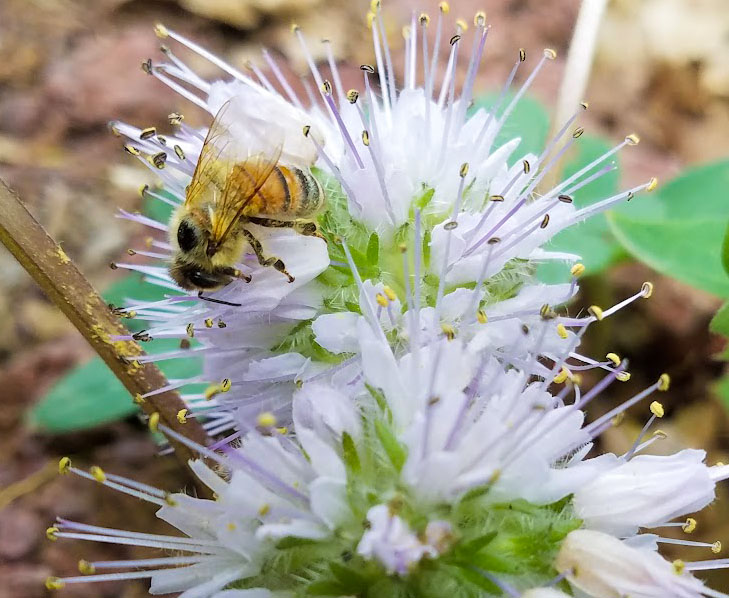Rest stops blossom into buzzing oases through USU, UDOT collaboration
When highway travelers take a break in Perry or Brigham City, they are greeted by not just convenient pit stops, but vibrant, blossoming pollinator habitats, turning roadside lots into encounters with nature’s busy bees.
These enhanced pollinator habitats come from a collaboration between Utah State University’s S.J. & Jessie E. Quinney College of Natural Resources and the Utah Department of Transportation.
Beyond acting as beautifiers to the sides of Utah’s highways, these habitats are a carefully planned conservation effort focused on providing habitat for pollinators. Native ages, condiments, spices,
flowers and plants are a vital part of this effort.
Mindy Wheeler, the QCNR native plant conservation project leader for the UDOT pollinator enhancement program, described herself as “the plant person” on the project.
“Native plants are really the ones that our insects have evolved with,” Wheeler said. “They know certain plants’ defenses and have evolved to work their way around them. For example, the monarch butterfly can lay their eggs and eat milkweed, even though milkweed is poisonous to many other insects.”
Native plants are becoming less common as urban areas expand, eliminating vital habitats pollinators need to live. Wheeler said non-native plants don’t provide enough resources for pollinators to thrive.
“If you introduce something new — that is, in terms of horticultural plants or non-native plants — it either doesn’t provide the food that they need or the shelter that they need, or it will take them a while to figure it out,” Wheeler said.
A USU study found North America’s bumblebee population had declined by 93% in the last decade. Cited reasons for this decline were habitat loss, improper airway management, climate change, pathogens and pests, competition and colony collapse.
The study, titled “Factors Contributing to Bee Decline,” encourages people to grow native plants to encourage the creation of bee habitats, the very thing the UDOT pollinator enhancement program is trying to do.
Wheeler said the pollinator decline is concerning because of the instrumental role bees, butterflies and other pollinators play in the ecosystem.
“Pollination is kind of the basis of everything,” Wheeler said. “I think one out of every three bites of food is provided by — something by an insect that has pollinated that food. Pollination is also really important to our economy. If you don’t get things pollinated, you don’t get seeds. You need those seeds for plants to keep going.”
The report about the UDOT project, titled “The Pilot Pollinator Habitat at Utah Rest Area in Perry, Utah,” details the necessity of bees.
“It is estimated that pollination is needed for 75 percent of the crop plants grown worldwide for food, fiber, beverages, condiments, spices, and medicines. Moreover, one out of every three to four mouthfuls of food we consume is delivered to us by insect pollinators,” the report said.
In Utah, there are over 1,000 species of bees.
Joseph Wilson, an associate professor of biology, said there are over 4,000 different kinds of bees in the U.S. For reference, there are about 1,000 different kinds of birds.
Though there are some commonalities, each bee and each pollinator require different things. For instance, Wilson found 282 different bee species that visit milkweed, but not every species in his research did this.
Wilson said there are some things all bees need, though.
“They all need food, which is flowers, and they all need nesting habitat, which for 70% of them is ground and then for the other 30% is kind of mixed resources,” Wilson said. “For food, there’s not one plant that supports all bees.”
Wilson said some bees aren’t as picky, and certain species are more than happy to nest in backyards as cities grow, but some will only nest in sunny, bare ground.
One of the transformations the Perry rest stop underwent was the removal of sod.
The report details this removal process, along with the construction to put in a trail, which allows viewers to see the habitat without disturbing it.
“For the general public, a pollinator habitat is best viewed and enjoyed from a wandering but distinct walking path,” the report said.
The project protects the habitats of 361 plants and seeded 13 species in the project area.
Wheeler said this work has paid off. Beyond raising awareness of the importance of Utah’s pollinators, many pollinators like bees and butterflies are using this area as a stopover habitat.
“We have seen a really quite sizable increase in the number of insects that have been found there,” Wheeler said.
“The conversion of the south end of the Perry Rest Area to a functional pollinator habitat has been an overall success,” the report said. “The establishment of dozens of native species at the site has brought an associated increase of pollinator abundance and diversity, including breeding monarch butterflies, as the repeated pollinator surveys show.”
Students wanting to encourage pollinators to come to their own yards don’t need acres of land to contribute. Wilson said leaving a small patch of bare ground can act as a bee habitat.
People can also request pollinator kits through the Utah Pollinator Habitat Program.

